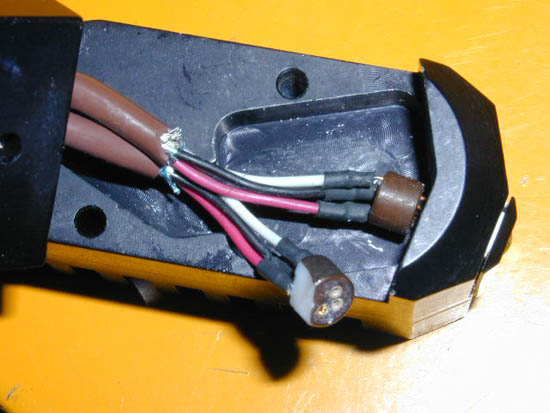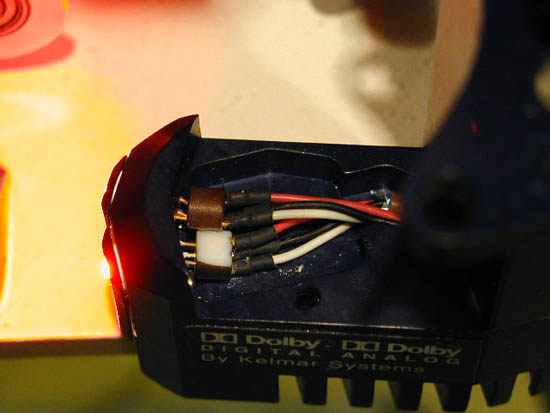|
|
This topic comprises 2 pages: 1 2
|
|
Author
|
Topic: Changing Dolby/Kelmar Analog LED
|
Manny Knowles
"What are these things and WHY are they BLUE???"

Posts: 4247
From: Bloomington, IN, USA
Registered: Feb 2002
|
 posted 08-16-2002 07:05 PM
posted 08-16-2002 07:05 PM




Since we are on the topic of analog LED kits, I also have a question:How do you replace a dead (or dying) LED in the Kelmar reverse-scan reader? Maybe a few photos would be best..? ~Manny (I try harder)
| IP: Logged
|
|
Richard Fowler
Film God

Posts: 2392
From: Ft. Lauderdale, FL, USA
Registered: Jun 2001
|
 posted 08-16-2002 08:14 PM
posted 08-16-2002 08:14 PM




manny,
on the Kelmar it is very easy. You will need the white "heat sink" compound available from most electronic stores ( and you should have already for "heat sinking" rectifier diodes also ). The replacement LED-V chip supplied by Dolby will have leads that will need to be trim to match the one that is removed. The chip itself has a reference bump which you must match position when installing the new chip. Remove cover holding chip....pull out old chip, after noting reference bump postion. The chip is plugged into a 3 pin female socket on the supply cable that you can see on the under side of the mount. When pulling out the old chip there are miniture teflon sleeves which reside in the holes of the bracket....if they come out , reseat them into the bracket for the new replacement to pass through. Apply heat sink compound, mount new LED-V chip,square up led array, put on LED clamp, and plug in female socket....5 minutes or less. Component Engineering mounts are almost the same with the female socket part of the flex power ribbon. The hardest one to work on is Cinemeccanica which requires hand soldering, but they where the first company to use basement units...so expect 15 minutes with a magnifier and a clamp to hold the heat sink.
| IP: Logged
|
|
Manny Knowles
"What are these things and WHY are they BLUE???"

Posts: 4247
From: Bloomington, IN, USA
Registered: Feb 2002
|
 posted 08-16-2002 10:05 PM
posted 08-16-2002 10:05 PM




Richard:Thanks for the reply. I have a batch of these LEDs to install and I will have help with the first few. I appreciate your instructions - I always like to know a little something before I get a tutorial...it eliminates the whole anxiety issue and it also makes me feel like less of an idiot when I'm being instructed. The replacement LEDs came with a small amount of heat-sink compound and, yes, I happen to have a tube here from the recent diode swapping. Where does this heat-sink compound go? I'm just curious. ~Manny (Fast, Fresh & Ready-To-Go.)
| IP: Logged
|
|
|
|
|
|
Manny Knowles
"What are these things and WHY are they BLUE???"

Posts: 4247
From: Bloomington, IN, USA
Registered: Feb 2002
|
 posted 08-17-2002 12:20 AM
posted 08-17-2002 12:20 AM




Richard: Thanks. Why didn't I think of that???Steve: Those are some really great photos. I was hoping I'd get to see stuff like that before "going in." This already feels like a stupid question, but I will ask it anyway... ...How much of an A-Chain will be required? The whole kit-and-caboodle? Or just a calibration of the LED and a Dolby level set? ~Manny (for whiter teeth and fresh breath.)
| IP: Logged
|
|
|
|
|
|
|
|
|
|
|
|
|
|
|
|
|
|
|
|
|
|
All times are Central (GMT -6:00)
|
This topic comprises 2 pages: 1 2
|
Powered by Infopop Corporation
UBB.classicTM
6.3.1.2
The Film-Tech Forums are designed for various members related to the cinema industry to express their opinions, viewpoints and testimonials on various products, services and events based upon speculation, personal knowledge and factual information through use, therefore all views represented here allow no liability upon the publishers of this web site and the owners of said views assume no liability for any ill will resulting from these postings. The posts made here are for educational as well as entertainment purposes and as such anyone viewing this portion of the website must accept these views as statements of the author of that opinion
and agrees to release the authors from any and all liability.
|

 Home
Home
 Products
Products
 Store
Store
 Forum
Forum
 Warehouse
Warehouse
 Contact Us
Contact Us




 Printer-friendly view of this topic
Printer-friendly view of this topic

















